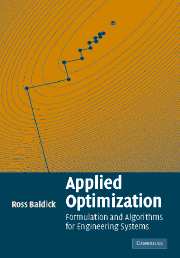Book contents
- Frontmatter
- Contents
- List of illustrations
- Preface
- 1 Introduction
- 2 Problems, algorithms, and solutions
- 3 Transformation of problems
- Part I Linear simultaneous equations
- Part II Non-linear simultaneous equations
- Part III Unconstrained optimization
- Part IV Equality-constrained optimization
- Part V Inequality-constrained optimization
- References
- Index
2 - Problems, algorithms, and solutions
Published online by Cambridge University Press: 03 December 2009
- Frontmatter
- Contents
- List of illustrations
- Preface
- 1 Introduction
- 2 Problems, algorithms, and solutions
- 3 Transformation of problems
- Part I Linear simultaneous equations
- Part II Non-linear simultaneous equations
- Part III Unconstrained optimization
- Part IV Equality-constrained optimization
- Part V Inequality-constrained optimization
- References
- Index
Summary
In this chapter we will define the various types of problems that we will treat in the rest of the book and define various concepts that will help us to characterize the problems. In Section 2.1, we first define the notion of a decision vector. In Section 2.2 we define two problems involving solution of simultaneous equations. Then in Section 2.3 we describe three optimization problems.
For each problem, we will provide an elementary example, without any context, to illustrate the type of problem. The case studies in later chapters will provide more interesting problems and contexts. In this chapter we will concentrate on basic definitions without explicitly considering applications.
In later chapters, we will also develop algorithms to solve the problems, starting with the elementary example problems introduced here and then progressing to solution of the case studies. We will explicitly define what we mean by an algorithm in Section 2.4 in reference to two general schemata:
direct algorithms, which, in principle, obtain the exact solution to the problem in a finite number of operations, and
iterative algorithms, which generate a sequence of approximate solutions or “iterates” that, in principle, converge to the exact solution to the problem.
We will also consider some of the issues involved in ensuring that these algorithms provide useful solutions. In particular, in Section 2.5, we will discuss solutions of simultaneous equations problems, introducing the concepts of a monotone function and of convex sets and presenting conditions for uniqueness of solutions of simultaneous equations.
- Type
- Chapter
- Information
- Applied OptimizationFormulation and Algorithms for Engineering Systems, pp. 15 - 102Publisher: Cambridge University PressPrint publication year: 2006

